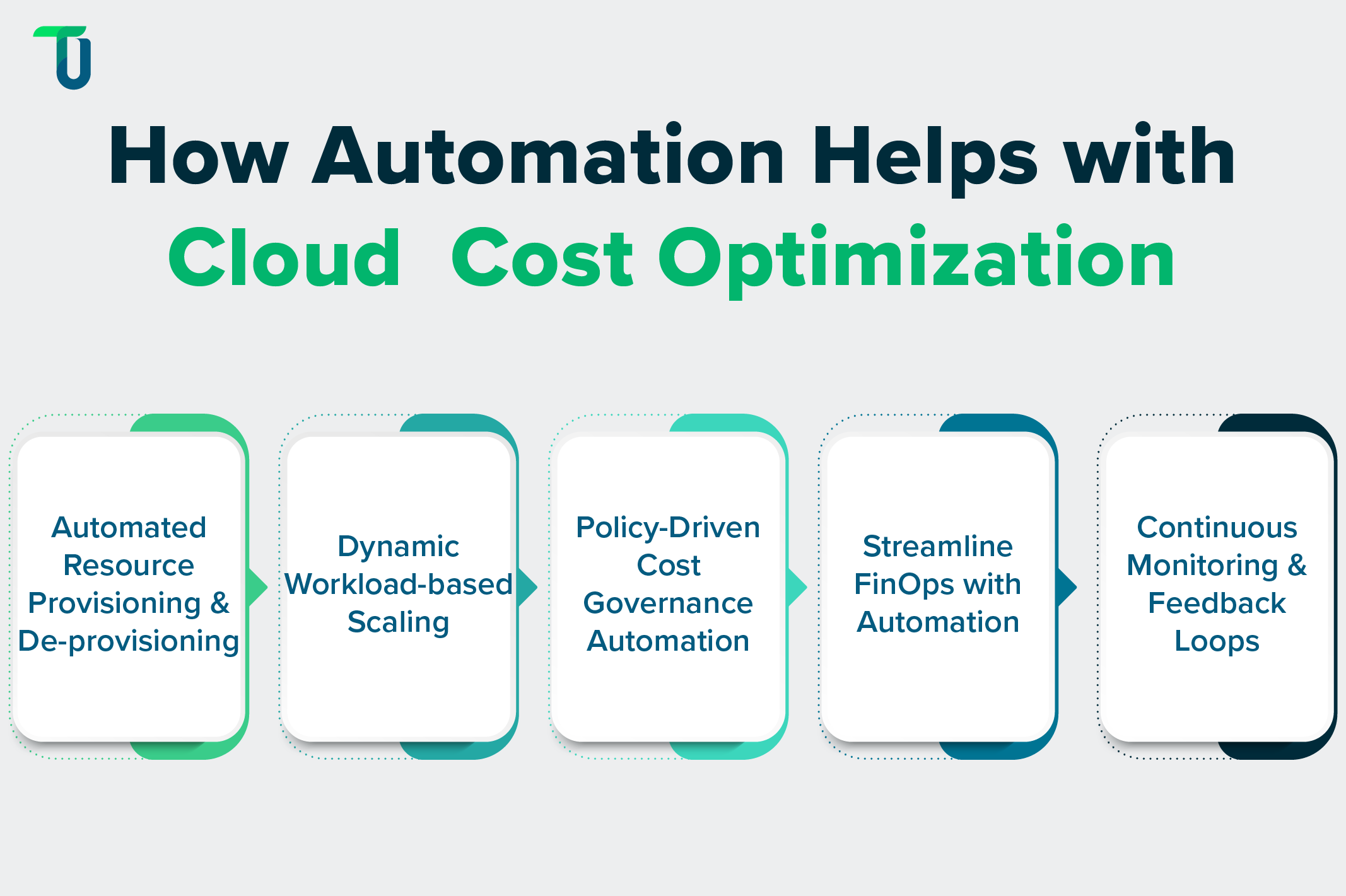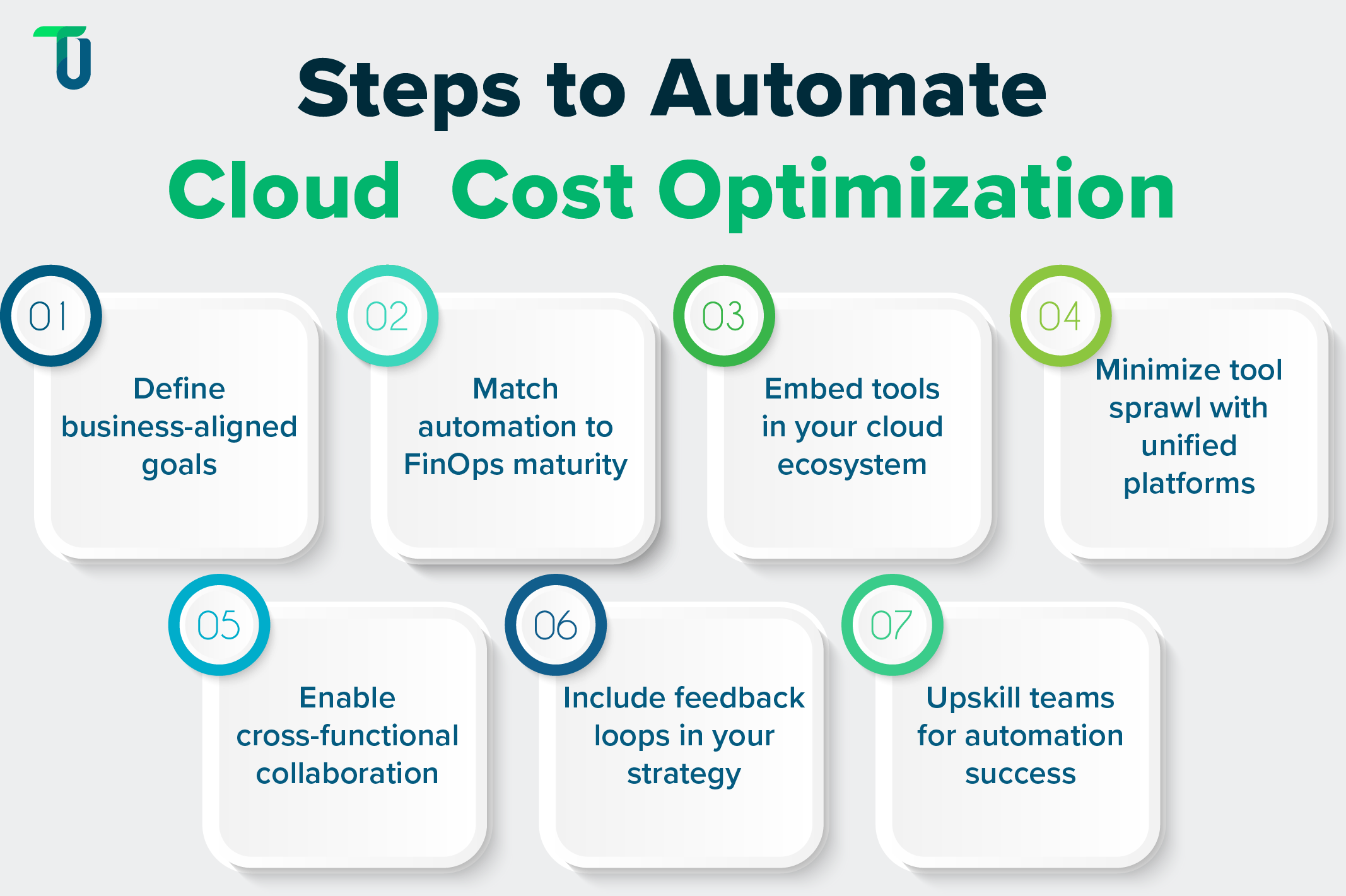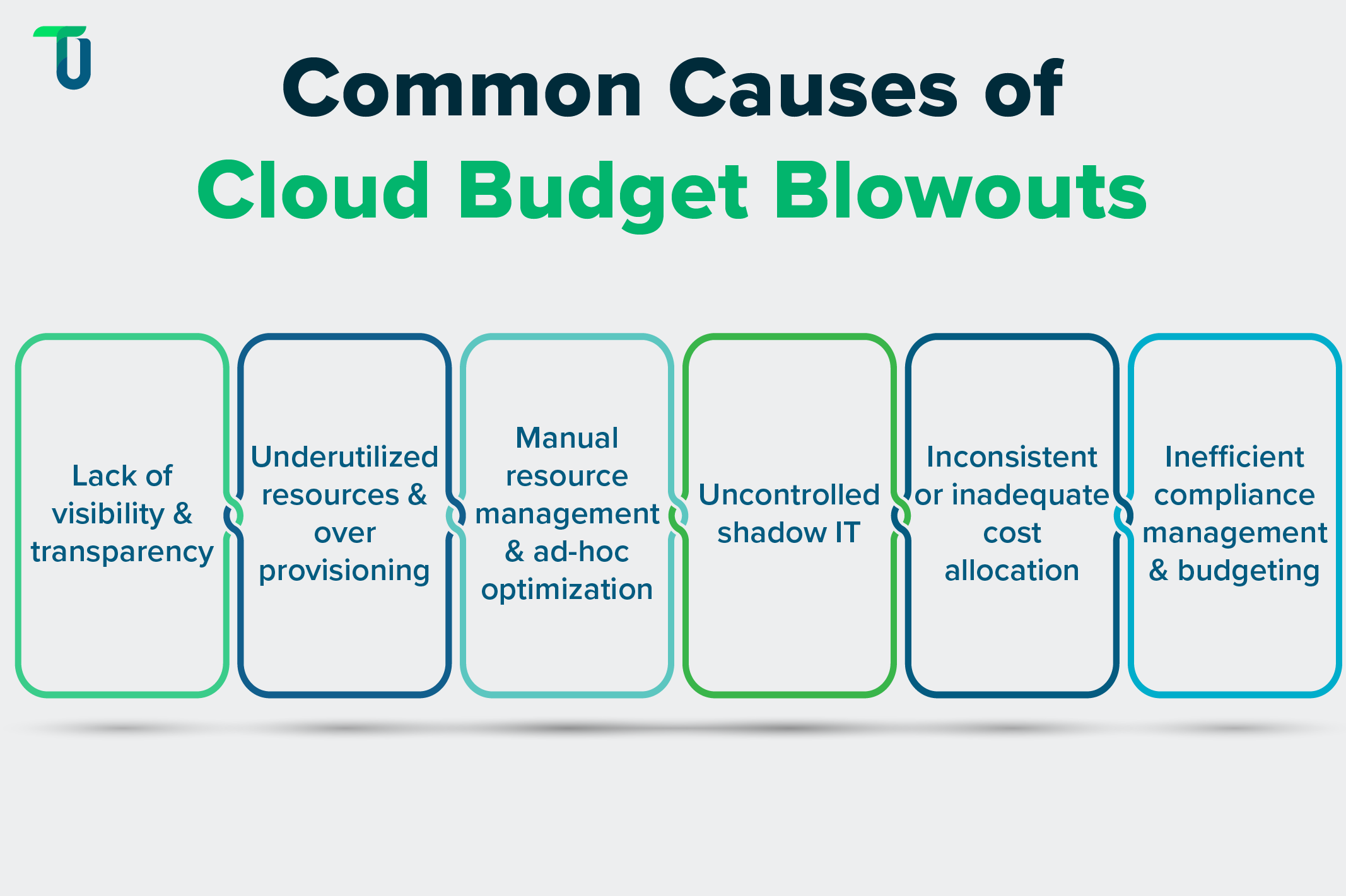Understanding FinOps: Bridging Finance and Technology
Cloud cost optimization isn't a post-mortem exercise. It’s a real-time discipline. And FinOps is how modern enterprises make that shift, from reactive cost tracking to proactive cloud optimization. At its core, FinOps aligns engineering, finance, and product teams around a single goal: maximizing cloud value per dollar spent. It does this by creating shared visibility, enabling accountability, and driving operational efficiency at scale. But visibility without action is noise.
That’s where automation turns intent into impact. When integrated with leading cloud cost optimization tools, FinOps practices become operationalized through automated tagging, policy enforcement, and real-time anomaly detection, rather than weeks later.
And for organizations leveraging cloud cost optimization services, the best outcomes come from partners who don’t just crunch numbers but build adaptive systems that enforce guardrails, reduce waste, and scale governance across environments. The result? A cloud cost optimization strategy that’s measurable, repeatable, and engineered for growth.
The Role of Automation in Cloud Cost Optimization
Managing cloud costs is no longer a luxury; it’s a necessity. With complex cloud environments and unpredictable workloads, manual cost management is simply not sustainable. That’s where automation comes in—not as an optional tool, but as the backbone of any serious cloud cost optimization strategy.

Automated Resource Provisioning and De-provisioning
Provisioning resources manually is like playing with fire—too many resources can burn a hole in your budget, too few can hurt performance. Automation eliminates this risk. By provisioning and de-provisioning resources automatically, cloud environments can scale on demand without manual intervention.
The result?
- You get the resources you need, exactly when you need them, and nothing more.
- Idle resources are automatically shut down, saving you money without sacrificing performance.
This level of efficiency is impossible without automation.
Dynamic Scaling Based on Workload Demands
Workloads are unpredictable. One minute, demand spikes, and the next, it drops. Predicting these fluctuations is near impossible. But automation? It can scale resources in real time based on actual demand.
What this means for you:
- During peak times, resources are automatically scaled up, ensuring smooth performance.
- During lulls, scaling down ensures you're not paying for what you don’t need.
- No more over-provisioning, no more unnecessary spend—just the right resources at the right time.
Policy-Driven Automation for Cost Governance
Cloud cost governance is a mess without proper policies. With teams managing various workloads, enforcing consistent cost control becomes a major challenge. Enter policy-driven automation.
Why this works:
- Policies are automatically enforced, like shutting down non-essential resources after hours or ensuring proper resource tagging.
- Cost overruns are flagged in real-time, ensuring that the right teams take action before the damage is done.
- Automation doesn’t just enforce rules; it enforces smart rules that prevent waste and keep your costs in check.
Streamlining FinOps with Automation
The disconnect between IT and finance often leads to inefficiency and unnecessary spending. Without clear visibility into cloud costs, decisions are made in the dark. Automation bridges that gap by integrating financial data with operational insights.
How it helps:
- Real-time visibility into cloud costs and usage patterns, enabling proactive decision-making.
- Accurate forecasting and budgeting, minimizing the chances of unexpected overruns.
- Automated alerts and anomaly detection so you can address issues before they spiral out of control.
With automation, FinOps becomes a continuous, seamless process—not a reactive, manual one.
Continuous Monitoring and Feedback Loops
Cloud environments are dynamic. What worked yesterday may not work today, which is why continuous monitoring is critical. Automation ensures that monitoring is constant, so you’re always in the loop.
What you get:
- Real-time tracking of resource usage, identifying inefficiencies as they occur.
- Predictive analytics that forecasts demand and offers optimization recommendations.
- Automated feedback loops to quickly adjust to changing workloads or new business needs.
In a world where change is the only constant, automation keeps you ahead of the curve.
Cloud cost optimization isn’t just about slashing budgets—it’s about smart, sustainable management. Automation is the key that unlocks this efficiency. By automating resource provisioning, scaling, governance, and monitoring, you not only reduce costs but also drive operational excellence.
For businesses looking to optimize cloud spend without compromising on performance, automation is no longer optional. It's the first step toward building a future-ready, cost-effective cloud strategy.
Stop Guessing. Start Optimizing.
Let TenUp automate the heavy lifting and turn cloud costs into strategic wins. Talk to our cloud experts today.
Implementing Automation: Best Practices for CTOs and CIOs
Automation isn’t a silver bullet. Without alignment, integration, and ownership, it becomes just another underutilized tool. For CTOs and CIOs, the focus must be on building a cloud cost automation strategy that’s not only technically sound but business-aligned and operationally embedded. Here’s how to implement automation with precision and purpose:

Start with clear objectives tied to business outcomes: Automation for the sake of efficiency isn’t enough. Define what success looks like— whether it’s reducing cloud waste by 30% , accelerating release cycles, or enforcing compliance across multi-cloud setups (see the benefits of private cloud for compliance for more on secure, regulation-friendly architectures). Your automation roadmap should directly support KPIs that matter to the business.
Align automation efforts with your FinOps maturity: If you’re in the early stages of FinOps, start with foundational automation, like resource scheduling, auto-tagging, or budget alerts. As your maturity evolves, scale to advanced capabilities like automated remediation and predictive scaling.
Integrate automation tools into your existing cloud management ecosystem: Look for tools that plug into your cloud-native stack—AWS Lambda, Azure Automation, GCP Cloud Functions—so workflows are seamless, not siloed. This reduces friction and accelerates adoption across teams.
To give you more precise examples, TenUp collaborated with a client to build a cloud-native application that leveraged AWS's capabilities. The implementation of an active-active node architecture and self-healing mechanisms not only ensured high availability but also optimized costs by reducing the need for manual interventions.
Avoid tool sprawl, choose platforms that offer visibility and control: Select cloud cost optimization tools that consolidate insights and actions. Unified dashboards, real-time alerting, and automated enforcement policies reduce the need for manual oversight, improving governance.
Foster cross-functional collaboration from day one: Automation impacts more than just IT—it also affects finance, DevOps, and business operations. Bring these stakeholders into the loop early to define cost guardrails, share ownership of outcomes, and ensure smooth implementation across functions.
Build feedback loops into your automation strategy: Set up regular reviews of automation performance. What’s working? What’s not triggering as expected? What’s saving the most money? Iterate often, using data to continuously refine your approach.
Upskill teams to work with automation, not around it: Automation is only as effective as the people using it. Train your cloud engineers, DevOps, and finance teams to understand how automation decisions are made—and how they can influence or override them when needed.
Automation done right doesn’t just cut costs—it builds a resilient, self-optimizing cloud foundation. And it starts with CTOs and CIOs leading from a position of clarity, alignment, and strategic intent.
Looking to build a stronger foundation before optimizing costs? Here’s why cloud migration services are key to achieving agile, secure growth.
Common Challenges of Cloud Cost Overruns & How Automation Solves These
Cloud spend is notoriously hard to predict. As companies scale, complexity rises—and so do costs. Overruns are a common issue, but they aren’t inevitable. With the right approach and automation in place, these challenges become solvable—and even more so when paired with cloud cost monitoring and optimization strategies that highlight key metrics to track and manage spending.
Here are the most frequent cloud cost overruns—and how automation can stop them in their tracks:

Lack of visibility and transparency: Without clear, real-time visibility into cloud usage, it’s easy to miss inefficiencies. Unused resources, underutilized instances, and mismanaged environments go unnoticed until the bill arrives.
Automated tagging and resource tracking provide real-time, granular visibility into every resource in your cloud ecosystem. Automation tools like CloudHealth or CloudZero can automatically categorize and report spend, so you can quickly identify areas for optimization without manual tracking.
Underutilized resources and over-provisioning: Over-provisioning occurs when cloud infrastructure is built with assumed demand, resulting in underutilized instances and higher costs. With rapid scaling, environments often end up with excess capacity.
Dynamic scaling automatically adjusts resources based on actual demand. Automation tools like AWS Auto Scaling or Google Cloud’s Instance Scheduler ensure resources are allocated efficiently, scaling up or down in real-time based on load—eliminating wasteful over-provisioning.
For instance, in our collaboration with a client in the maritime and education sectors, we implemented a compliant AWS architecture with self-healing capabilities. This not only ensured 99.99% uptime but also led to significant cost savings and operational efficiency.
Manual resource management and ad-hoc optimization: Many organizations still rely on manual processes to manage resources, making it difficult to keep up with cloud sprawl and evolving requirements. This often results in reactive cost management—scrambling to fix problems after they happen.
With automated provisioning, deprovisioning, and workload scheduling, automation ensures cloud resources are efficiently managed 24/7. Tools like Terraform and CloudFormation can automatically deploy infrastructure and ensure that configurations are in line with cost optimization best practices.
Uncontrolled shadow IT: Unapproved resources, or shadow IT, can easily accumulate without being flagged—leading to unexpected costs that aren’t accounted for in the budget.
Automation tools can enforce governance policies and set up automatic alerts for any unapproved usage or non-compliant resources. By integrating identity and access management (IAM) tools with cloud cost optimization solutions, you can automatically flag unauthorized deployments and prevent shadow IT from going unchecked.
Inconsistent or inadequate cost allocation: Without proper cost allocation tags and structures, it is next to impossible to understand which department or project is driving cloud spend.
Automated cost allocation ensures every resource is tagged, tracked, and assigned to the appropriate team, project, or business unit. This creates accountability and transparency, making it easier to pinpoint cost overruns. Many cloud providers offer built-in tagging solutions, combined with cloud cost optimization tools, to automate this process.
Inefficient compliance management and budgeting: Regulatory requirements, industry standards, and internal policies require strict adherence to budgets and spend limits. Manual tracking can result in missed deadlines or excessive spending.
Automation allows for real-time compliance tracking, and when paired with the benefits of private cloud for compliance , it can create a robust framework for meeting regulatory requirements while optimizing costs. With automated budget alerts and predefined policies (like automatic shut-off or scaling actions), cloud cost optimization tools ensure that resources stay within budget limits and compliance requirements are always met.
Cloud cost overruns don’t have to be a recurring issue. With automated controls in place and efficient cloud cost management, organizations can prevent waste, increase efficiency, and maintain visibility, ultimately reducing cloud spend while ensuring performance and scalability remain intact.
Automation is Just the Beginning: Optimize with TenUp
Automation is no longer a nice-to-have—it’s the foundation for building a lean, intelligent cloud. But real impact? That comes when automation is part of a larger strategy. For CTOs and CIOs, that means adopting cloud cost optimization strategies that go beyond short-term savings to deliver long-term, scalable value.
At TenUp, we help you move from reactive to proactive with end-to-end cloud solutions services tailored to your business goals. Our approach combines automation, intelligence, and engineering depth to eliminate waste, drive efficiency, and create continuous optimization loops.
Here’s how we do it:
- Deploying intelligent, policy-driven cloud optimization frameworks that adapt to workload patterns in real-time.
- Integrating top-tier cloud cost optimization tools to monitor, automate, and govern usage without manual overhead.
- Designing scalable cloud cost optimization strategies that align cost with performance across multi-cloud and hybrid environments.
- Enabling FinOps maturity with clear accountability and cross-functional visibility—so finance, IT, and operations stay in sync.
Whether you're trying to rein in cloud sprawl, cut runaway costs, or build a resilient cloud financial model, TenUp delivers automation-led optimization, backed by engineering precision and enterprise-grade support.
Let’s turn your cloud into a growth enabler, not a cost center.
Your Cloud Doesn’t Need More Tools- It Needs a Smarter Strategy.
Discover how our automation-first approach to cloud cost optimization can transform your bottom line. Get your personalized optimization roadmap.
Frequently asked questions
What are the most effective tools for automating cloud cost optimization?
Top tools for automating cloud cost optimization include AWS Cost Explorer, Azure Cost Management, Google Cloud Recommender, and third-party platforms like CloudHealth, Spot.io, and Harness. These tools offer automation for rightsizing, resource scheduling, and cost forecasting to maximize cloud efficiency.
How does AI enhance cloud cost optimization strategies?
AI boosts cost efficiency by predicting usage trends, detecting anomalies, and automating resource scaling, helping cut waste without impacting performance.
What are common mistakes companies make in cloud cost optimization?
Key mistakes in cloud cost optimization include overprovisioning, ignoring idle resources, and not using cost monitoring tools, leading to wasted spend and missed savings. Failing to align costs with business goals also limits long-term efficiency.
How can DevOps teams contribute to cloud cost optimization?
DevOps teams help reduce cloud costs by automating infrastructure with scripts, monitoring resource usage, and ensuring efficient deployments. By adopting Infrastructure as Code and FinOps principles, they enable smarter scaling and better cost accountability.
What role does FinOps play in cloud cost optimization?
FinOps drives cloud cost optimization by aligning finance and operations, enabling real-time cost tracking, and promoting shared accountability. It ensures teams make informed, value-driven cloud spending decisions.
How can organizations prevent shadow IT from inflating cloud costs?
Organizations can curb shadow IT by enforcing strict access controls, conducting regular audits, and using centralized cloud monitoring tools. Promoting awareness, offering approved alternatives, and involving IT in procurement decisions also help reduce unauthorized usage and hidden costs.
What strategies can be employed to optimize costs in multi-cloud environments?
Use unified monitoring, consistent tagging, and automated policies to track and manage usage across providers. Prioritize cost-effective services, eliminate idle resources, and align workloads with the best-fit cloud offerings.

